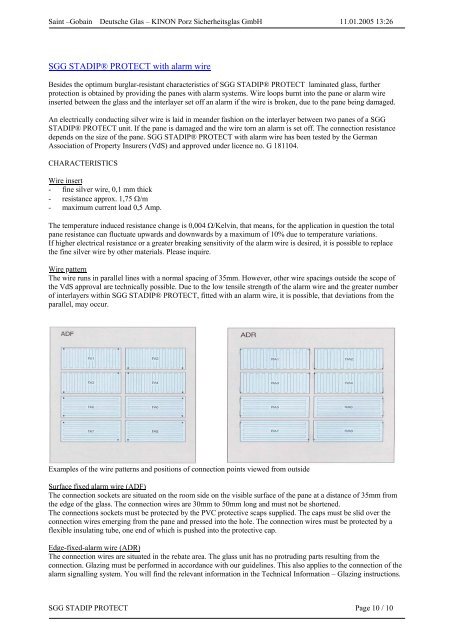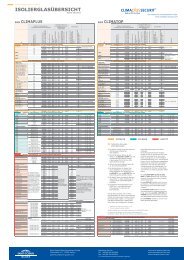SGG STADIP® PROTECT - Saint-Gobain Glass
SGG STADIP® PROTECT - Saint-Gobain Glass
SGG STADIP® PROTECT - Saint-Gobain Glass
Create successful ePaper yourself
Turn your PDF publications into a flip-book with our unique Google optimized e-Paper software.
<strong>Saint</strong> –<strong>Gobain</strong> Deutsche Glas – KINON Porz Sicherheitsglas GmbH 11.01.2005 13:26<br />
<strong>SGG</strong> <strong>STADIP®</strong> <strong>PROTECT</strong> with alarm wire<br />
Besides the optimum burglar-resistant characteristics of <strong>SGG</strong> <strong>STADIP®</strong> <strong>PROTECT</strong> laminated glass, further<br />
protection is obtained by providing the panes with alarm systems. Wire loops burnt into the pane or alarm wire<br />
inserted between the glass and the interlayer set off an alarm if the wire is broken, due to the pane being damaged.<br />
An electrically conducting silver wire is laid in meander fashion on the interlayer between two panes of a <strong>SGG</strong><br />
<strong>STADIP®</strong> <strong>PROTECT</strong> unit. If the pane is damaged and the wire torn an alarm is set off. The connection resistance<br />
depends on the size of the pane. <strong>SGG</strong> <strong>STADIP®</strong> <strong>PROTECT</strong> with alarm wire has been tested by the German<br />
Association of Property Insurers (VdS) and approved under licence no. G 181104.<br />
CHARACTERISTICS<br />
Wire insert<br />
- fine silver wire, 0,1 mm thick<br />
- resistance approx. 1,75 Ω/m<br />
- maximum current load 0,5 Amp.<br />
The temperature induced resistance change is 0,004 Ω/Kelvin, that means, for the application in question the total<br />
pane resistance can fluctuate upwards and downwards by a maximum of 10% due to temperature variations.<br />
If higher electrical resistance or a greater breaking sensitivity of the alarm wire is desired, it is possible to replace<br />
the fine silver wire by other materials. Please inquire.<br />
Wire pattern<br />
The wire runs in parallel lines with a normal spacing of 35mm. However, other wire spacings outside the scope of<br />
the VdS approval are technically possible. Due to the low tensile strength of the alarm wire and the greater number<br />
of interlayers within <strong>SGG</strong> <strong>STADIP®</strong> <strong>PROTECT</strong>, fitted with an alarm wire, it is possible, that deviations from the<br />
parallel, may occur.<br />
Examples of the wire patterns and positions of connection points viewed from outside<br />
Surface fixed alarm wire (ADF)<br />
The connection sockets are situated on the room side on the visible surface of the pane at a distance of 35mm from<br />
the edge of the glass. The connection wires are 30mm to 50mm long and must not be shortened.<br />
The connections sockets must be protected by the PVC protective scaps supplied. The caps must be slid over the<br />
connection wires emerging from the pane and pressed into the hole. The connection wires must be protected by a<br />
flexible insulating tube, one end of which is pushed into the protective cap.<br />
Edge-fixed-alarm wire (ADR)<br />
The connection wires are situated in the rebate area. The glass unit has no protruding parts resulting from the<br />
connection. Glazing must be performed in accordance with our guidelines. This also applies to the connection of the<br />
alarm signalling system. You will find the relevant information in the Technical Information – Glazing instructions.<br />
<strong>SGG</strong> STADIP <strong>PROTECT</strong> Page 10 / 10

















